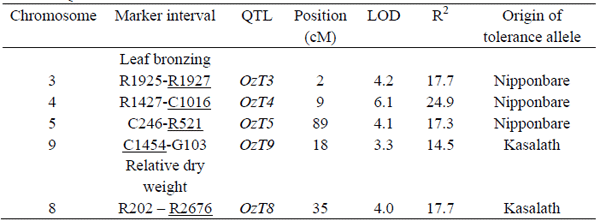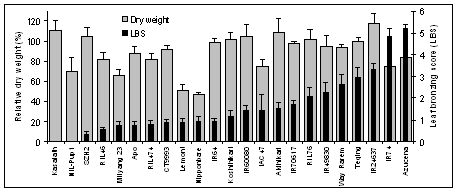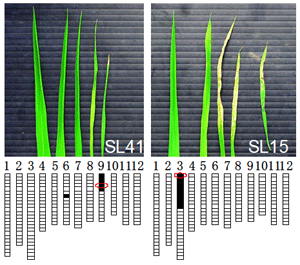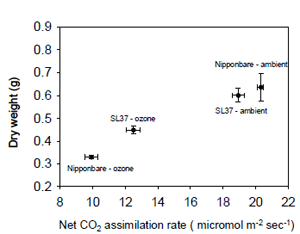Genotypic variation in response to elevated surface ozone in rice and genetic factors contributing to tolerance
Description
At current ozone levels, rice yield losses due to ozone are estimated to be between 5-10%, but with surface ozone concentrations expected to rise in many rice-producing areas of East and South Asia, yield losses as a result of exposure to elevated ozone will increase and could reach 20% in highly affected areas. Losses of that magnitude would threaten food security in East and South Asia, unless new rice cultivars with improved tolerance to ozone can be developed. The present study investigates whether genotypic variation for ozone tolerance exists in rice and subsequently identifies the quantitative trail loci (QTL) associated with tolerance.
The different responses to elevated ozone were evaluated in 23 rice genotypes of different origins and plant types that had been grown in open top chambers in a greenhouse. Ozone fumigation was done for 14 days from 9 am to 4 pm at a constant level of 100 ppb. Ambient air with ozone concentrations not exceeding 20 ppb was used as a control. Rice genotypes differed in their response to ozone with some genotypes such as Azucena or IR74 showing very strong leaf symptoms while others like Nipponbare or Milyang 23 showing reductions in biomass (Fig 1). Kasalath appeared to be the least affected by ozone.
QTL mapping based on the Nipponbare x Kasalath mapping population identified four QTLs for leaf bronzing and one QTL associated with biomass loss (Table 1). Of the four QTLs for leaf bronzing, the tolerant parent, Kasalath, contributed the tolerance allele in only one case, OzT9 on chromosome 9. In three cases, tolerance alleles were derived from intolerant Nipponbare. In contrast, Kasalath contributed the tolerance allele at the only QTL associated with biomass reduction (OzT8). Chromosome segment substitution lines carrying small Kasalath inserts in a Nipponbare genetic background were used in comparison to recurrent parent Nipponbare to confirm the effects of QTLs OzT3, OzT8 and OzT9. Kasalath introgressions at QTL OzT9 (SL 41) reduced leaf bronzing but at QTL OzT3 (SL15) increased bronzing(Fig 2). Further analysis of leaf material from SLs indicated that genotypic differences in leaf bronzing are related to differences in leaf ascorbic acid content (data not shown). The reduction in plant biomass due to ozone exposure was high in Nipponbare (Fig. 3) but less in SL37 carrying a Kasalath introgression at QTL OzT8 and this was due to a less pronounced reduction in net CO2 assimilation rate in SL37.
The genotypic variation in tolerance to elevated ozone present in rice appears sufficiently large to allow for improvements in rice ozone tolerance through breeding. The QTL identified and confirmed in this study could represent an important first step in the development of a breeding strategy to transfer tolerance loci from donors such as Kasalath to susceptible high-yielding cultivars.
Figure, table
-
Table 1 QTL associated with tolerance to elevated ozone
-
Fig. 1.
Effect of 14 day-exposure to elevated ozone (100 ppb) on rice genotypes, evaluated in terms of leaf bronzing and relative dry weight (dry weight in the ozone treatment relative to ambient air control). -
Fig 2.
Differences in ozone-induced leaf bronzing between substitution lines SL41 and SL15 confirm the effect of both QTLs.Leaves are arranged from youngest leaf (left) to oldest leaf (right). Intolerant SL15 has already lost the three older leaves as a result of two week exposure to 100 ppb ozone whereas the effect of ozone exposure on SL41 is small. Graphical genotypes show Kasalath introgressions (black bars) at QTLs OzT9 in SL41 (chromosome 9) and at QTL OzT3 in SL15 (chromosome 3) -
Fig. 3.
Photosynthetic efficiency (CO2 assimilation) as affected by ozone in Nipponbare and derived line SL37 that carried Kasalath introgressions at QTL OzT8.
- Affiliation
-
Japan International Research Center for Agricultural Sciences Crop Production and Environment Division
- Classification
-
Technical A
- Term of research
-
FY2008(FY2006~2011)
- Responsible researcher
-
WISSUWA Matthias ( Crop Production and Environment Division )
FREI Michael ( Crop Production and Environment Division )
- ほか
- Publication, etc.
-
Frei M., Pariasca Tanaka J. and Wissuwa M. (2008) Genotypic variation in tolerance to elevated ozone in rice: Dissection of distinct genetic factors linked to tolerance mechanisms. Journal Experimental Botany 59, 3741-3752.
- Japanese PDF
-
2008_seikajouhou_A4_ja_Part5.pdf521.6 KB




